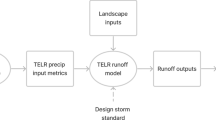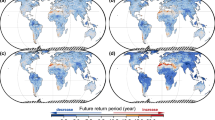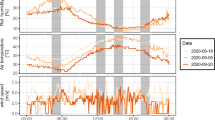Abstract
Roadway design aims to maximize functionality, safety, and longevity1,2. The materials used for construction, however, are often selected on the assumption of a stationary climate1,3. Anthropogenic climate change may therefore result in rapid infrastructure failure and, consequently, increased maintenance costs, particularly for paved roads where temperature is a key determinant for material selection. Here, we examine the economic costs of projected temperature changes on asphalt roads across the contiguous United States using an ensemble of 19 global climate models forced with RCP 4.5 and 8.5 scenarios. Over the past 20 years, stationary assumptions have resulted in incorrect material selection for 35% of 799 observed locations. With warming temperatures, maintaining the standard practice for material selection is estimated to add approximately US$13.6, US$19.0 and US$21.8 billion to pavement costs by 2010, 2040 and 2070 under RCP4.5, respectively, increasing to US$14.5, US$26.3 and US$35.8 for RCP8.5. These costs will disproportionately affect local municipalities that have fewer resources to mitigate impacts. Failing to update engineering standards of practice in light of climate change therefore significantly threatens pavement infrastructure in the United States.
This is a preview of subscription content, access via your institution
Access options
Access Nature and 54 other Nature Portfolio journals
Get Nature+, our best-value online-access subscription
$29.99 / 30 days
cancel any time
Subscribe to this journal
Receive 12 print issues and online access
$209.00 per year
only $17.42 per issue
Buy this article
- Purchase on Springer Link
- Instant access to full article PDF
Prices may be subject to local taxes which are calculated during checkout



Similar content being viewed by others
References
Huang, Y. H. Pavement Analysis and Design (Prentice Hall, 1993).
Yoder, E. J. & Witczak, M. W. Principles of Pavement Design (John Wiley, 1975).
Asphalt Institute Superpave Performance Graded Asphalt Binder Specifications and Testing Superpave Series No. 1 (SP-1) (Asphalt Institute, 2003).
National Research Council Committee on Climate Change (NRC) Potential Impacts of Climate Change on US Transportation (National Research Council, 2008).
Meyer, M. et al. Strategic Issues Facing Transportation, Volume 2: Climate Change, Extreme Weather Events, and the Highway System: Practioner’s Guide and Research Report NCHRP Report 750 (National Cooperative Highway Research Program, 2014).
Anderson, T., Beck, C., Gade, K. & Olmsted, S. Extreme Weather Vulnerability Assessment FHWA No. 0704-0188.FHWA (Arizona Department of Transportation, 2015).
Cambridge Systematics Central Texas Extreme Weather and Climate Change Vulnerability Assessment of Regional Transportation Infrastructure FHWA No. 0704-0188 (Capital Area Metropolitan Planning Organization, 2015).
Koetse, M. J. & Rietveld, P. The impact of climate change and weather on transport: an overview of empirical findings. Transp. Res. 14, 205–221 (2009).
IPCC Climate Change and Cities: First Assessment Report of the Urban Climate Change Research Network (eds Rosenzweig, C., Solecki, W. D., Hammer, S. A.& Mehrotra, S.) (Cambridge Univ. Press, 2011).
United States Department of Transportation (USDOT) Transportation in the United States (Bureau of Transportation Statistics, 2015).
United States Department of Transportation (USDOT) US Beyond Traffic 2045: Trends and Choices (US Department of Transportation, 2015).
American Society of Civil Engineers (ASCE) 2013 Report Card for Americas Infrastructure (2013); http://www.infrastructurereportcard.org
IPCC Climate Change Impacts in the United States: The Third National Climate Assessment (eds Melillo, J. M., Terese, R. & Yohe, G. W.) 841 (US Global Change Research Program, 2014).
Knutti, R. & Sedlacek, J. Robustness and uncertainties in the new CMIP5 climate model projections. Nat. Clim. Change 3, 369–373 (2013).
Mearns, L. et al. The North American regional climate change assessment program: overview of phase I results. Bull. Am. Meteorol. Soc. 93, 1337–1362 (2012).
Woldemeskel, F. M., Sharma, A., Sivakumar, B. & Mehrotra, R. Quantification of precipitation and temperature uncertainties simulated by CMIP3 and CMIP5 models. J. Geophys. Res. 121, 3–17 (2016).
Wuebbles, D. et al. CMIP5 climate model analysis: climate extremes in the United States. Bull. Am. Meteorol. Soc. 95, 571–583 (2014).
United States Department of Transportation (USDOT) National Transportation Statistics (Bureau of Transportation Statistics, accessed March 2016); https://www.rita.dot.gov/bts/sites/rita.dot.gov.bts/files/publications/national_transportation_statistics/index.html
Chinowsky, P. & Arndt, C. Climate change and roads: a dynamic stressor-response model. Rev. Dev. Econ. 16, 448–462 (2012).
Chinowsky, P. S., Price, J. C. & Neumann, J. E. Assessment of climate change adaptation costs for the US road network. Glob. Environ. Change 23, 764–773 (2013).
Daniel, J. S., Jacobs, J. M., Douglas, E., Mallick, R. B. & Hayhoe, K. Impact of climate change on pavement performance: preliminary lessons learned through the infrastructure and climate network (ICNet). Int. Symp. Climatic Effects Pavement Geotechnical Infrastructure (Fairbanks AK, 2013).
Fletcher, C. G., Matthews, L., Andrey, J. & Saunders, A. Projected changes in mid-twenty-first-century extreme maximum pavement temperature in Canada. J. Appl. Meteorol. Climatol. 55, 961–974 (2016).
Harvey, M. et al. Impact of Climate Change on Road Infrastructure Report No. AP-R243/04 (Austroads and the Bureau of Transport and Regional Economics, 2004).
Meagher, W., Daniel, J. S., Jacobs, J. & Linder, E. Method for evaluating implications of climate change for design and performance of flexible pavements. Trans. Res. Record J. Trans. Board 2305, 111–120 (2012).
Mills, B. N., Tighe, S. L., Andrey, J., Smith, J. T. & Huen, K. Climate change implications for flexible pavement design and performance in Southern Canada. J. Trans. Eng. 135, 773–782 (2009).
Mndawe, M. B., Ndambuki, J. & Kupolati, W. K. Revision of the macro climatic regions of Southern Africa. OIDA Int. J. Sustainable Dev. 6, 37–44 (2013).
Schweikert, A., Chinowsky, P., Espinet, S. & Tarbert, M. Climate change and infrastructure impacts: comparing the impact on roads in ten countries through 2100. Procedia Eng. 78, 306–316 (2014).
Viola, F. & Celauro, C. Effect of climate change on asphalt binder selection for road construction in Italy. Transp. Res. 37, 40–47 (2015).
Kunkel, K. E., Liang, X. Z. & Zhu, J. Regional climate model projections and uncertainties of US summer heat waves. J. Clim. 23, 4447–4458 (2010).
Maurer, E. P., Brekke, L., Pruitt, T. & Duffy, P. B. Fine-resolution climate projections enhance regional climate change impact studies. Eos Trans. Am. Geophys. Union 88, 504 (2007).
Climate Analytics Group Downscaled CMIP3 and CMIP5 Climate and Hydrology Projections (US Department of the Interior, Bureau of Reclamation, Technical Service Center, accessed September, 2015); ftp://gdo-dcp.ucllnl.org/pub/dcp/archive/cmip5/bcca
Reclamation Downscaled CMIP3 and CMIP5 Climate Projections: Release of Downscaled CMIP5 Climate Projections, Comparison with Preceding Information, and Summary of User Needs 116 (US Department of the Interior, Bureau of Reclamation, Technical Service Center, 2013); http://gdo-dcp.ucllnl.org/downscaled_cmip_projections/techmemo/downscaled_climate.pdf
Huber, G. A. Weather Database for the Superpave Mix Design System SHRP-A-648A (Strategic Highway Research Program, 1994).
Johnson, N. L. & Kotz, S. Continuous Univariate Distributions: Chapter 24 – Beta Distributions (Houghton Mifflin Company, 1970).
Zapata, C. E. & Cary, C. E. Integrating the National Database of Subgrade Soil-Water Characteristic Curves and Soil Index Properties With the MEPDG Final Report NCHRP 9-23b (National Cooperative Highway Research Program, 2012).
Applied Research Associates Guide for Mechanistic-Empirical Design of New and Rehabilitated Pavement Structures Final Report NCHRP 1-37A (National Cooperative Highway Research Program, National Research Council, 2004).
Darter, M. I., Glover, L. T., Von Quintus, H., Bhattacharya, B. B. & Mallela, J. Calibration and Implementation of the AASHTO Mechanistic-Empirical Pavement Design Guide in Arizona FHWA-AZ-14-606 FHWA (Arizona Department of Transportation, 2014).
Heitzman, M., Timm, D., Tackle, E. S., Herzmann, D. E. & Traux, D. D. Developing MEPDG Climate Data Input Files for Mississippi FHWA/MS-DOT-RD-11-232. FHWA (Mississippi Department of Transportation, 2011).
Pierce, L. M. & McGovern, G. Implementation of the AASHTO Mechanistic-Empirical Pavement Design Guide and Software Project 20-05, Topic 44-06 (National Cooperative Highway Research Program, 2014).
Smith, B. & Nair, H. Development of Local Calibration Factors and Design Criteria Values for Mechanistic-Empirical Pavement Design FHWA/VCTIR 16-R1.FHWA (Virginia Center of Transportation, 2015).
VonQuintus, H. L. & Moulthrop, J. S. Mechanistic-Empirical Pavement Design Guide Flexible Pavement Performance Prediction Models for Montana, Volume III: Field Guide Calibration and Users Guide for the Mechanistic-Empirical Pavement Design Guide FHWA/MT-07-008/8158-3.FHWA (Montana Department of Transportation, 2007).
Witczak, M. W., Zapata, C. E. & Houston, W. N. Models Incorporated into the Current Enhanced Integrated Climatic Model, Final Report (National Cooperative Highway Research Program, 2006).
Fwa, T. F., Pasindu, H. R. & Ong, G. P. Critical rut depth for pavement maintenance based on vehicle skidding and hydroplaning consideration. J. Trans. Eng. 138, 423–429 (2011).
Lamptey, G., Ahmad, M. Z., Labi, S. & Kumares, C. S. Life Cycle Cost Analysis for INDOT Pavement Design Procedures FHWA/IN/JTRP-2004/28 (Indiana Department of Transportation, 2005).
New York Department of Transportation (NYDOT) Comprehensive Pavement Design Manual: Chapter 5 Rehabilitation (NYDOT Design Division and Technical Service Division, 2002).
Santero, N. Life Cycle Assessment of Pavements: A Critical Review of Existing Literature and Research (Lawrence Berkeley National Laboratory, 2010); https://www.osti.gov/scitech/servlets/purl/985846
Walls, J. & Smith, M. R. Life Cycle Cost Analysis in Pavement Design - Interim Technical Bulletin FHWA-SA98-079 (Federal Highway Administration, 1998).
National Highway Planning Network (NHPN) National Highway Planning Network - Tools - Processes - Planning (accessed March 2015); http://www.fhwa.dot.gov/planning/processes/tools/nhpn
NIST/SEMATECH e-Handbook of Statistical Methods (National Institute of Standards and Technology, 2012); http://www.itl.nist.gov/div898/handbook
Acknowledgements
We acknowledge the World Climate Research Program’s Working Group on Coupled Modeling, which is responsible for CMIP, and we thank the climate modelling groups (listed in Supplementary Table 1) for producing and making available their model output. For CMIP the US Department of Energy’s Program for Climate Model Diagnosis and Intercomparison provides coordinating support and led development of software infrastructure in partnership with the Global Organization for Earth System Science Portals. We would also like to acknowledge the Climate Assessment for the Southwest (CLIMAS) at the University of Arizona for providing support to Z. Guido.
Author information
Authors and Affiliations
Contributions
B.S.U. designed the study, identified the data sources, created the scripts to analyse the climate data, and developed the structure of the paper in collaboration with Z.G. and P.G.; Z.G. provided inputs on climate modelling and ensemble interpretation and review of the manuscript; P.G. reviewed the manuscript and discussed interpretation of the data at length; Y.F. assisted in downloading, cataloguing, and running the climate scripts. All authors contributed equally to developing the ideas in this paper.
Corresponding author
Ethics declarations
Competing interests
The authors declare no competing financial interests.
Supplementary information
Supplementary Information
Supplementary Information (PDF 1659 kb)
Rights and permissions
About this article
Cite this article
Underwood, B., Guido, Z., Gudipudi, P. et al. Increased costs to US pavement infrastructure from future temperature rise. Nature Clim Change 7, 704–707 (2017). https://doi.org/10.1038/nclimate3390
Received:
Accepted:
Published:
Issue Date:
DOI: https://doi.org/10.1038/nclimate3390
This article is cited by
-
Implication of future temperature changes on asphalt binder selection and simulated pavement performance in Sharjah
Innovative Infrastructure Solutions (2024)
-
Adoption of Asphalt Binder Performance Grades for Morocco Considering Climate Change
International Journal of Civil Engineering (2023)
-
Impact of Climate Change on Pavement Performance in Canada’s Newfoundland Island
International Journal of Pavement Research and Technology (2023)
-
Identifying key processes and sectors in the interaction between climate and socio-economic systems: a review toward integrating Earth–human systems
Progress in Earth and Planetary Science (2021)
-
Climate effects on US infrastructure: the economics of adaptation for rail, roads, and coastal development
Climatic Change (2021)



